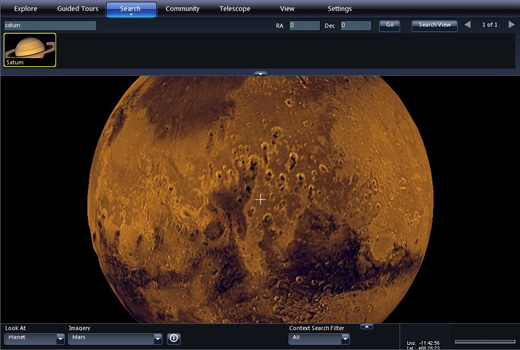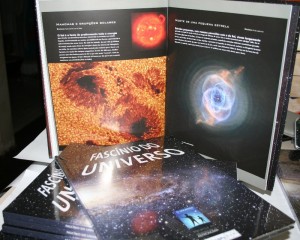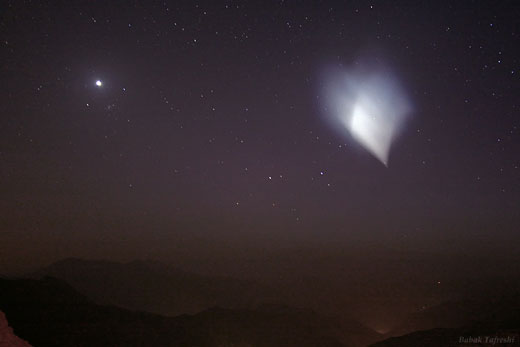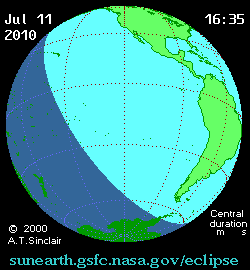IYA2009 Updates
A Scale Model of our Solar System
13 July 2010
The solar system is a really big and empty place. It's so big and empty that it's difficult to create a scale model where both the sizes of the planets and their orbits are correct. For example, if we scale Pluto down to about as small as we can go, let's say 1 mm in diameter, then the Sun at the same scale would be about 60 cm across. The surprising thing is that at this scale, the distance between the Sun and Pluto would be 2.5 km!
http://www.umanitoba.ca/observatory/outreach/solarsystem/index.html
This webpage provides a tool for visualizing the solar system at various scales. You pick a size for the Sun, and all the planets and their orbital distances are scaled according to this value. The orbits are then overlaid on a map that is centred wherever you like (maybe your school or your house or a landmark in your city). We start you off with a map of Winnipeg (because that's where this website is based!), but you can change this to any location by entering the coordinates or by zooming out and panning around.
NASA and Microsoft Provide Mars 3-D Close Encounter
13 July 2010

NASA and Microsoft Research are bringing Mars to life with new features in the WorldWide Telescope software that provide viewers with a high-resolution 3-D map of the Red Planet. Microsoft’s online virtual telescope explores the universe using images NASA spacecraft return from other worlds. Teams at NASA’s Ames Research Center in Moffett Field, Calif., and Microsoft in Redmond, Wash., jointly developed the software necessary to make NASA’s planetary data available in WorldWide Telescope.
“By providing the Mars dataset to the public on the WorldWide Telescope platform, we are enabling a whole new audience to experience the thrill of space,” said Chris C. Kemp, chief technology officer for information technology at NASA Headquarters in Washington.
The fully-interactive images and new NASA data will allow viewers to virtually explore Mars and make their own scientific discoveries. New features include the highest resolution fully interactive map of Mars ever created, realistic 3-D renderings of the surface of the planet and video tours with two NASA scientists, James Garvin of NASA’s Goddard Space Flight Center in Greenbelt, Md., and Carol Stoker of Ames.
Garvin’s tour walks viewers through the geological history of Mars and discusses three possible landing sites for human missions there. Each landing site highlights a different geological era of the planet. Stoker’s tour addresses the question “Is there life on Mars?” and describes the findings of NASA’s Mars Phoenix Lander. “Our hope is that this inspires the next generation of explorers to continue the scientific discovery process,” said Ames Center Director S. Pete Worden.
The Intelligent Robotics Group at Ames Research Center developed open source software that runs on the NASA Nebula cloud computing platform to create and host the high resolution maps. The maps contain 74,000 images from Mars Global Surveyor’s Mars Orbiter Camera and more than 13,000 high-resolution images of Mars taken by the Mars Reconnaissance Orbiter’s High Resolution Imaging Science Experiment (HiRISE) camera. Each individual HiRISE image contains more than a billion pixels. The complete maps were rendered into image mosaics containing more than half a billion smaller images.
“These incredibly detailed maps will enable the public to better experience and explore Mars,” said Michael Broxton, a research scientist in the Intelligent Robotics Group at Ames. “The collaborative relationship between NASA and Microsoft Research was instrumental for creating the software that brings these new Mars images into people’s hands, classrooms and living rooms.” NASA’s Mars Reconnaissance Orbiter (MRO) reached the planet in 2006 to begin a two-year primary science mission. The mission has returned more data about Mars than all other spacecraft sent to the Red Planet. The Global Surveyor began orbiting Mars in 1997. The spacecraft operated longer than any other Mars spacecraft, ceasing operations in November 2006.
“Microsoft has a long-standing relationship with NASA that has enabled us to jointly provide the public with the ability to discover space in a new way,” said Tony Hey, corporate vice president of the External Research Division of Microsoft Research.
To learn more and download the WorldWide Telescope, visit:
http://www.worldwidetelescope.org/whatIs/WhatIsWWT.aspx?Page=Mars
Free astronomy ebook in Portuguese
13 July 2010

In the framework of IYA2009, the Brazilian National Node has jut released a book about the Universe. The book in PDF can be downloaded here: http://www.astro.iag.usp.br/fascinio.pdf
Crowdsourcing the search for aliens
13 July 2010
The SETI Institute's Jill Tarter is looking for a few good filters.
Research from the Search for Extra-Terrestrial Intelligence (SETI) project is well known to most technologists because the SETI@Home initiative was one of the first widely distributed computing applications.
MEDEA Awards 2010
12 July 2010
Closing Date for MEDEA Awards 31 July 2010!
The closing date for the MEDEA awards is coming up soon and so we invite all producers of media resources to submit their entries by 31 July. Entry to the MEDEA Awards is free!This year there are two main MEDEA Awards, the MEDEA Overall Award and the European Collaboration Award. The European Collaboration Award recognizes excellent media-based productions and projects that come about as a result of European cross-border collaboration. This year the organisers are making a distinction between professional and non-professional producers, awarding the best entry in each category. You can submit your entry in French, English or German and once your entry is completed, you can then follow its progress online.
Prizes and Awards
Prizes in 2009 included software and hardware as well as the MEDEA bronze statuette for the overall winner. In addition, all finalists will be invited to Brussels to take part in the Media & Learning conference which will include sessions dedicated to different media applications led by winners and finalists of the MEDEA awards 2008, 2009 and 2010.
Call for Judges
The MEDEA Awards Jury is made up of over 70 professionals working in the media and learning sectors. They include educational media producers, practitioners experienced in the use of media for education and training and stakeholders in relevant organisations all over Europe. Many of them are working with organisations that are part of the network of National Contact Points in 26 different European countries who help to promote MEDEA. Online judging takes place this year in August and September and if you would like to volunteer as a judge, please visit our website and register your interest.
MEDEA Awards incorporated in Media & Learning Conference
This year the MEDEA Awards will provide a core element in the new Media & Learning: towards the era of digital fluency Conference which is being organised in collaboration with the Flemish Ministry of Education and the European Commission Directorate-General for Education and Culture on 25-26 November in the Flemish Ministry of Education Headquarters in Brussels to coincide with the Belgian Presidency of the European Union. More information about taking part in this conference is available from the conference website: http://www.media-and-learning.eu
Contact information
For more information about MEDEA, please contact the MEDEA Secretariat:Nikki Cortoos, MEDEA SecretariatAddress: ATiT, Leuvensesteenweg 132, B-3370 Roosbeek, BelgiumTel: +32 16 284 040, Fax: +32 16 223 743E-mail: secretariat@medea-awards.com
Astronomy Night on the US National Mall
12 July 2010
15 July 2010 (rain date 16 July 2010), 6 p.m. to 11 p.m.
Hofstra University’s Astronomy Outreach Program and the White House Office of Science and Technology Policy (OSTP) are teaming up to host a free public stargazing party on the National Mall in Washington, D.C.
Astronomy Night on the National Mall expands upon the success of Hofstra’s two-year-old NASA-funded Music and Astronomy Under the Stars program, which brings telescopes to concertgoers on Long Island, NYC, and at Tanglewood Music Center and is run by Dr. Donald Lubowich, Coordinator of Astronomy Outreach at Hofstra. Lubowich and OSTP planned the National Mall event to coincide with a performance of the U.S. Marine Corp Band at the Sylvan Theater on the Mall that night.
“Bringing Hofstra’s program to the National Mall and partnering with the White House is a very special opportunity for us to promote public science education and encourage children to pursue classes and careers in science,” Dr. Lubowich said. “There’s just something awe inspiring about gazing at the rings of Saturn, or the Moon, that captures the imagination, no matter how old you are.”
Dr. Lubowich and local volunteers from the National Capital Astronomers and the Northern Virginia Astronomy Club will set up telescopes, posters, and video equipment for multimedia presentations just northeast of the Washington Monument, between 14th and 15th Streets NW and Madison Drive and Constitution Ave. Starting at 6 p.m., visitors will be able to gaze at the Sun with the help of specially filtered telescopes. After dusk and until 11 p.m. telescopes will provide close-up views of the crescent Moon, Venus, Mars, Saturn, star clusters, and nebulae. Click here to view a map of where Astronomy Night on the Mall will be held.
“Astronomy Night on the National Mall” will take place just blocks away from the South Lawn of the White House, where President Obama hosted a star party last October. Both events are part of the Obama Administration’s ongoing effort to inspire more boys and girls to become interested in classes and careers in science, technology, engineering, and math.
For more information and the 2010 schedule for “Astronomy and Music Under Stars” go to www.hofstra.edu/underthestars.
Solve a Mystery at the World at Night
12 July 2010

Each month TWAN brings you a photo with a mystery. While some of the photos display a real mystery of unidentified object or phenomena, some others are already solved by TWAN team and appear here for educational purposes. TWAN post the explanation or the final conclusion at the month’s end. This program is a collaboration with Unidentified Aerospace Phenomena (UAP) international project.
More information: http://www.twanight.org/newTWAN/mystery.asp?archive=yes&id=1002
The ¨7th Small and Portable Planetarium¨ gathering in Jyväskylä, Finland
11 July 2010
The 7th Small and Portable Planetarium gathering is going to be held at the Planetarium Kallioplanetaario in Jyväskylä, Finland, during the period 17-20 August 2010.
The gathering is organized by the planetarium Kallioplanetaario located in Jyväskylä (centre of Finland).
Preliminary program available here: http://sites.google.com/a/kallioplanetaario.fi/planetaariokokous/program
Total Solar Eclipse of 11 July 2010 -- LIVE
10 July 2010
11 July will feature another total solar eclipse.The eclipse will be visible over much of the southern Pacific Ocean, touching several small islands including Tuamotu in French Polynesia and Easter Island, as well as the southern tips of Argentina and Chile in South America.

To allow astronomers and the public all around the world to witness this spectacle different organisations will be hosting a live broadcast of the eclipse:
In partnership with the Canary Island-based Shelios Association, the Universidad Politécnica de Madrid's Ciclope Group, based at the Facultad de Informática and led by Francisco Manuel Sánchez Moreno, is set to broadcast from Easter Island (Chile) the total solar eclipse due on 11 July 2010 at 22.08 Central European Time via this web site.
The Exploratorium ais also broadcasting the eclipse. More information: http://www.exploratorium.edu/eclipse/2010/index.html
More information and list of webcasts: http://thilinaheenatigala.blogspot.com/2010/07/watch-live-total-solar-eclipse-of-july.html
Thanks to this broadcast, citizens of the world will all be able to share in the experience of witnessing a solar eclipse.
IYA2009 Updates
9 July 2010
Buy 5 Galileoscopes, Get 1 Free!
Galileoscopes are in stock and available for rapid delivery - no more long waits. New prices are $30 each for 1 to 5 kits, or $150 for a case of 6 ($25 each); that’s like getting 1 free for every 5 you buy at the regular price! Ongoing support for teachers and others using Galileoscopes with students and the public is now available through NOAO’s Teaching With Telescopes website: http://www.TeachingWithTelescopes.org. Also, through a generous donation from Ric and Jean Edelman, 1 to 5 **FREE** Galileoscopes are available to U.S. primary-, middle-, and secondary-school teachers; recipients pay only for shipping/handling. For details, go to http://www.galileoscope.org and click on the Order Now! link. Now is the time to order Galileoscopes for use in your Fall 2010 education and outreach programs!
Hubble Pop Culture Contest: For the past 20 years the Hubble Space Telescope has brought you the most breathtaking images of the Universe. Now it’s your turn to look for astonishing examples of Hubble pictures, or pictures of Hubble, used in unexpected places. More information: http://www.spacetelescope.org/projects/20anniversary/hubblepopculture/
Total Solar Eclipse of 11 July 2010 -- LIVE
11 July will feature another total solar eclipse.The eclipse will be visible over much of the southern Pacific Ocean, touching several small islands including Tuamotu in French Polynesia and Easter Island, as well as the southern tips of Argentina and Chile in South America. More information: http://www.astronomy2009.org/news/updates/973/
The World at Night Newsletter July 2010
http://www.astronomy2009.org/news/updates/971/
Europlanet honours Jean Lilensten with first Prize for Excellence in Public Engagement: http://www.astronomy2009.org/news/updates/970/
Archaeoastronomy and ethnoastronomy conference: building bridges between cultures: http://www.astronomy2009.org/news/updates/969/
Astro Book Drive Update
In 2008 "Ghana Science Project" built the first public planetarium in Accra, Ghana the only digital planetarium in West, East or Central Africa. The planetarium gave a good boost in astronomy education in Ghana. Since it's inauguration in 2008, the planetarium has come a long way serving and educating many students and public. Education & Public Outreach Unit of Cornell University (USA), currently running a book drive to facilitate Ghana Science Project to improve their astronomy outreach efforts. Read more: http://astrodrive.lakdiva.net/projects/ghana_bookdrive.html
3D atlas of the universe TED talk online
Following the global success of the YouTube move The Known Universe, with over five million views, Carter Emmart, director of astrovisualization at the American Museum of Natural History in New York was invited to present at the well-renowned TED Talks in February 2010. Watch the video: http://www.astronomy2009.org/news/updates/967/
Search IYA2009 Updates

National Nodes: 148
Organisational Nodes: 40
Organisational Associates:33
National Websites: 111
Cornerstone Projects: 12
Special Task Groups: 11
Special Projects:16
Official Products:8
Media Partners:22


